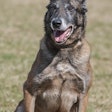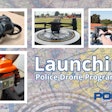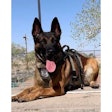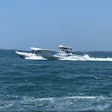In Afghanistan during Operation Anaconda on March 4, 2002, Air Force combat medic Jason Cunningham was shot several times, and while saving fellow comrades he bled to death an hour before help arrived. The same has happened to countless police officers unable to immediately reach medical attention.
Medical personnel have known for years that approximately 80 percent of combat deaths occur within 30 minutes of wounding, often because of loss of blood.
Bleeding, or acute hemorrhage in medical terms, is a leading cause of death in trauma cases among the civilian population. And that includes police officers. If you can stop the bleeding you can save lives.
In both law enforcement and military operations, gunshot wound victims under certain situations may be prevented from being immediately evacuated. Police officers are often first on the scene of a shooting or motor vehicle accident, where effective and immediate early hemorrhage control (hemostasis) is essential to saving lives. This becomes even more important when an injured officer must be able to effectively self-apply a bandage without assistance or control the bleeding of a fellow officer or injured victim.
New hemostatic bandages currently being marketed contain agents that make blood clot more quickly than the body can on its own. The faster the blood clots, the less blood is lost and the better chance the victim has to survive. Recently, tactical medics, both law enforcement and military, have had success with this new technology.
Hemostatic Bandages
Currently, there are several new bloodclotting hemostatic bandages on the market or being tested. Each takes a different approach to stopping bleeding, and each has advantages and disadvantages. Anyone who can apply a bandage can use these products. Within reason, this covers just about everyone in medicine, the military, and law enforcement.
The benefits are lives saved, at least in theory. Therefore, the topic is a must for unbiased discussion.
Blood clotting is the body’s way of closing a wound to prevent blood loss.
For small wounds, a clot begins to form a mesh of platelets and blood cells within one to two minutes.
If, however, the wound is large and the blood flow is under pressure, such as in a wound to the femoral artery in the thigh, the normal clotting mechanism fails to stop the bleeding, and the victim can bleed to death within a few minutes.
Hemostatic bandages are made to supplement the body’s clotting process to stop bleeding.
Readers are strongly urged to carefully conduct their own investigation to determine what is best for their agency, team, and level of training. It should also be noted that the information in this article was obtained from the manufacturers, representatives from the companies, and from physicians, surgeons, and medics who have actually used these products on the battlefield.
HemCon
HemCon Bandage is manufactured by Hem-Con Inc. of Tigard, Ore. It uses a material called Chitosan, a biodegradable, nontoxic, complex carbohydrate of chitin, which is found in the exoskeletons of shellfish.
It will not cause an allergic reaction, according to product literature. A recent study by the U.S. Army Institute of Surgical Research looked at the effectiveness of a chitosan-based hemostatic dressing to prevent blood loss in swine. Based on the results, the team concluded that a chitosan dressing reduced hemorrhage and improved survival after severe liver injury in swine and that further studies are warranted.
The bandage is designed for immediate hemorrhage control and is deployable by an injured soldier, combat medic, or an untrained first responder. The bandage has been tested in animal models of severe bleeding by the U.S. Army and other laboratories.
Company literature claims HemCon is superior to all known hemorrhage dressings. But John Hagman, M.D., medical director for the FBI Hostage rescue team, reported at the December 2003 Special Operations Medical Association (SOMA) conference in Orlando, Fla., that a recent study completed for the U.S. Air Force showed HemCon had a significant failure rate.
The disadvantage for most agencies is the price. One package of five, 4x4-inch bandages is packaged in a sterile foil pouch and is priced at $495. In addition, the product has only a six month shelf life.
QuikClot
QuikClot is manufactured by Z-Medica of Newington, Conn. According to product literature, newspaper articles, and press releases from Z-Medica, Quik- Clot was used extensively during Operation Iraqi Freedom. The active ingredient in the product is called granular zeolite, a substance derived from lava rocks. When this material is placed into a bleeding wound, it absorbs the water molecules in the blood and creates a high platelet concentration to promote clotting. This causes an exothermic reaction. In other words, it gives off heat.
Several U.S. Navy physicians who served in Iraq report that QuikClot produces sufficient heat to cause burns to the skin if measures are not taken to wipe off water, sweat, and excess blood from the wound and skin before use. In fact, Navy Corpsmen that served with Marine combat units in Iraq reported they observed “second-degree burns” in Iraqi soldiers treated with QuikClot.
QuikClot concentrates clotting factors in the blood by promoting extremely rapid adsorption of fluids in and around the wound, creating a matrix for clot formation.
As per product literature instructions, QuikClot is to be poured directly onto an open bleeding wound where it promotes formation of a stable powerful clot. The clot, according to Z-Medica, is then easily removed through suction or irrigation of the wound when the patient arrives at a care facility.
The exact formula of QuikClot is proprietary, but it contains no biological or botanical material, thus decreasing the chance of an allergic reaction.
Although some organizations are not completely sold on QuikClot, the Navy and Marines performed a limited study using a swine model and were impressed with the results enough to issue the product to combat medics serving in Afghanistan and Iraq.
In a press release packet sent to us from Z-Medica dated April 9, 2003, company Vice President Bart Gullong was quoted saying, “Based on QuikClot’s performance in Operation Iraqi Freedom, we are now gearing up production to accommodate even faster worldwide adoption of it by all first responders: police, firefighters, EMTs, and anyone who is first on the scene of a severe bleeding injury.”
In contrast, Brian Drummond MC, USNR, who served as the surgeon for the 3rd Batallion, 4th Marines, 7th Regiment, 1st Marine Division between March and April 2003 in Iraq and treated 140 casualties on the battlefield never used nor witnessed the use of QuikClot while there. Drummond, who had 54 Navy Corpsmen under his command, says that although QuikClot was available in their medical bags, none of them used Quik- Clot, nor was it ever needed. “The extremity wounds were all controlled with direct pressure and tourniquet,” says Drummond.
The Uniformed Services University of the Health Sciences (USUHS) was asked by the Marine Corps to evaluate the continued use of QuikClot. Col. David G. Burris, M.D., interim chairman of the U.S.U. Department of Surgery, chaired the panel. The panel reinforced the FDA’s recommendation that QuikClot should be used only for life-threatening hemorrhaging after conventional hemorrhage control efforts have failed. It also reported that it should only be used to treat external wounds, and then only after standard hemostatic techniques to control bleeding have failed, according to a report released Feb. 26, 2003.
Lt. Bruce Webb, Battalion Surgeon, 2nd Tank Battalion attached to the 1st Marine Expeditionary Force, saw action in central Iraq from March 20 to May 30, 2003 and reported to us his first-hand battlefield experience with QuikClot.
In one instance, the product dried the wound but then flaked off so much that gauze was used more effectively. In another case, blood gushed out of a female patient’s wound so profusely that the product was always flushed out of the wound. The victim died.
In Webb’s experience, QuikClot is not very effective on the battlefield. “It doesn’t stop bleeding as advertised in the real world,” he says. “We are better off focusing on the established techniques of pressure, packing, and dressing.”
Webb also found that 25 percent of the packets he received had leaked and absorbed water so they were unusable. What he found most worrisome, however, was the potential for burns resulting from use of the product.
“Exothermic reactions can cause second-degree burns on surrounding tissue. It is impossible to dry the wound enough to prevent burning. If you can dry the wound that well, you don’t need QuikClot.”
QuikClot packaging has a net weight of 3.5 ounces, and is vacuum-packed in a sterile, compact, and waterproof 5x7-inch packet. It is heat sealed on all four sides. The top of the packet has an easy tear notch. Labeling on both front and back includes instructions, diagrams, and warnings. The retail price is $21.99 per packet.
[PAGEBREAK]
RDH
Rapid Deployment Hemostat Bandage, or RDH, is manufactured by Marine Polymer Technologies in Danvers, Mass. The material used to promote blood clotting, poly-N-acetylglucosamine (p-GlcNAc), is derived from single-cell algae found in the ocean.
The RDH Bandage enables field personnel with minimum training to rapidly and efficiently stop arterial and other hemorrhage resulting from extremity trauma. The development of the RDH battlefield dressing is the result of a successful collaboration between Marine Polymer Technologies and the Office of Naval Research.
When the RDH Bandage comes in contact with blood, it stimulates platelet activation, which leads to the secretion of a substance known as Thromboxane. The Thromboxane stimulates the constriction of blood vessels near the wound, which helps slow blood flow there. According to literature from Marine Polymer Technologies, the mechanism of poly-N-acetylglucosamine applied directly to the bleeding wound via a bellows applicator. TraumaDEX is packaged in sterile .5-gram, 2-gram and 5-gram applicators that are small, extremely lightweight, and fit anywhere in your trauma kit.
To use TraumaDEX, remove any excess blood from the wound site using a bandage or gauze. Apply the TraumaDEX powder to the bleeding source and immediately apply direct pressure.
The St. Paul (Minn.) Department of Fire and Safety Services paramedic units are currently using TraumaDEX to assist in wound management with severe bleeding in the pre-hospital setting. Other studies on the effectiveness of TraumaDEX include the Mayo Clinic and the Minneapolis Medical Research Foundation. However, results are not available.
TraumaDEX does not cause an exothermic reaction, so there is no risk of secondary burns to the skin as is found with QuikClot. Also unlike QuikClot, TraumaDEX is reabsorbed naturally by the body within hours and does not need to be washed out of the wound prior to definitive wound repair. It is also very reasonably priced. The 0.5-gram package is $7, the 2-gram package is $15, and the 5-gram package is $25. TraumaDEX is biocompatible, and there is no risk of transmission of disease or immune response. The shelf life for unopened packages is three to five years.
Urgent QR
Urgent QR is manufactured by Biolife LLC based in Sarasota, Fla. The material is composed of a non-toxic polymer and a potassium salt along with a bovine based thrombin material. The following information was supplied in monograph, prepared by John W. Roberts, PhD, director of technology, at Biolife.
According to company literature, Biolife’s initial core brand is QR (Quick Relief) powder, a wound dressing and highly cost-effective topical powder that stops bleeding instantly. It also acts as a protective barrier and bactericide to protect wounds.
There are several other products, each with a specific use. For example, Super QR is for major or severe wounds, Urgent QR is for minor wounds, Nosebleed QR is for nosebleeds, and Oral QR is for oral wounds and to stop bleeding due to oral surgery and tooth extractions.
Product literature supplied by Biolife states a 96-percent success rate in an ongoing clinical study treating lacerations, nosebleeds, skin tears, punctures, and abrasions. Normally, for minor wounds, no covering bandage is required.
Clinical evaluation trials of QR were studied by David Letts, M.D., at the Sarasota Medical Center in Sarasota, Fla. However, no results have been published.
QR Powder works independently of the normal blood clotting mechanism of blood clotting. QR Powder was tested by an independent FDA-licensed testing laboratory and showed neither toxicological nor allergenic effects.
Urgent QR is available either in four, 30, or 100-blister packs per box. All versions of the QR products are packaged in hermetically sealed blisters to maximize product shelf life. The cost, according to company literature, is around $1.70 for the consumer in a 30-blister pack and around $2 for the professional product in a 30-blister pack.
What Works?
Each hemostatic dressing is derived from a different source. One is derived from algae, one from potato starch, another from lava rock, another from the thrombin in cow’s blood, and yet another from marine exoskeletons (chitin).
And they come in different forms: Some are powders and other are bandages. But all of these products have at least one thing in common: Their manufacturers claim that they work in seconds.
The question law enforcement agencies must ask is, “Do they really work?” and what should they consider for purchase and distribution to patrol officers?
Unfortunately, there are conflicting reports in the medical literature regarding what bandage is the most effective. Some product literature from the manufacturers claims the U.S. Military has had extensive success using their products in the field. In our investigation this was found not to be true.
This issue is further clouded by conflicting reports and anecdotal evidence obtained from personal interviews with surgeons, emergency physicians, nurses, and Navy Corpsmen who treated combat casualties during the war in Iraq.
Unlike drugs that require years of testing and approval by the FDA, the manufacturers of hemostatic dressings are not required by law to conduct extensive research to support their claims.
After conducting our review, it is the opinion of the authors that more scientific studies should be conducted by independent agencies and organizations that have no financial relationships or conflict of interest with the manufacturers.
When these studies are completed, the medical community will have a better picture of which product is the most effective and cost efficient.
Useful Tips
If you do choose to use one of these dressings, you can use certain techniques to ensure you get the best results possible and enhance their efficacy.
It stands to reason that if the bleeding is under high pressure or very brisk, none of these products is going to work. You’ll need to apply direct pressure to the wound or to a pressure point above the wound. If you get the bleeding slowed with a pressure point, you might be able to get the wound dry enough to apply the material into the wound and allow it to work. After the dressing is complete, the tourniquet or pressure point may be released.
What would make the ideal hemostatic agent? It should be inexpensive, not cause allergic reactions, not need to be washed out, and able to be delivered into any kind of wound. Above all, it should work and not cause any harm.
There is one thing we do know and that is that the time-honored method of using direct pressure and a tourniquet for a bleeding injury really works. It seems prudent that a police officer should use the simplest and easiest technique in the field for hemorrhage control.
We recommend that law enforcement agencies proceed with caution before spending valuable resources on the new blood-clotting agents available until further studies are done and stick with old-fashioned direct pressure and tourniquets.
Lawrence E. Heiskell, M.D., FACEP, FAAFP, is a practicing emergency physician, a reserve police officer, and a tactically trained SWAT team physician with the Palm Springs (Calif.) Police Department, as well as a member of the Police Advisory Board.
Bohdan T. Olesnicky, M.D., is a practicing emergency physician who serves as a tactical medic and SWAT team physician with the Clifton (N.J.) Police Department and the Saint Barnabas Healthcare System Special Operations Division in Livingston, N.J.
Sydney J. Vail, M.D., FACS, is the director of trauma & trauma critical care at the Carilion Health System Level 1 Trauma Center in Roanoke, Va., and a member of the Tactical EMS Support team for the Salem (Va.) Emergency Response Team.
















